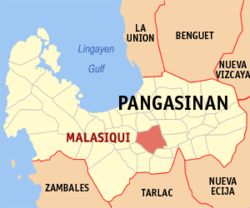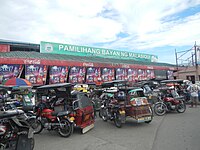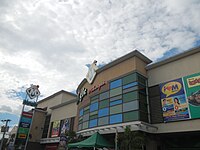Malasiqui
Malasiqui | |
|---|---|
| Municipality of Malasiqui | |
 Panoramic | |
 Map of Pangasinan with Malasiqui highlighted | |
Location within the Philippines | |
| Coordinates: 15°55′N 120°25′E / 15.92°N 120.42°E | |
| Country | Philippines |
| Region | Ilocos Region |
| Province | Pangasinan |
| District | 3rd district |
| Founded | January 22, 1671 |
| Barangays | 73 (see Barangays) |
| Government | |
| • Type | Sangguniang Bayan |
| • Mayor | Noel Anthony M. Geslani |
| • Vice Mayor | Armando C. Domantay Sr. |
| • Representative | Maria Rachel J. Arenas |
| • Municipal Council | Members |
| • Electorate | 85,815 voters (2022) |
| Area | |
| • Total | 131.37 km2 (50.72 sq mi) |
| Elevation | 21 m (69 ft) |
| Highest elevation | 87 m (285 ft) |
| Lowest elevation | 5 m (16 ft) |
| Population (2020 census)[3] | |
| • Total | 143,094 |
| • Density | 1,100/km2 (2,800/sq mi) |
| • Households | 34,428 |
| Economy | |
| • Income class | 1st municipal income class |
| • Poverty incidence | 19.33 |
| • Revenue | ₱ 362.2 million (2020), 160.8 million (2012), 174.3 million (2013), 197 million (2014), 222.7 million (2015), 241.8 million (2016), 284.1 million (2017), 315.1 million (2018) |
| • Assets | ₱ 698.5 million (2020), 265.9 million (2012), 271.9 million (2013), 321.5 million (2014), 401 million (2015), 464.8 million (2016), 486.4 million (2017), 573.9 million (2018) |
| • Expenditure | ₱ 339.7 million (2020), 143.5 million (2012), 157.4 million (2013), 163.2 million (2014), 170 million (2015), 182.9 million (2016) |
| • Liabilities | ₱ 110.3 million (2020), 97.75 million (2012), 83.47 million (2013), 96.71 million (2014), 123.6 million (2015), 127.4 million (2016), 80.65 million (2017), 103.1 million (2018) |
| Service provider | |
| • Electricity | Central Pangasinan Electric Cooperative (CENPELCO) |
| Time zone | UTC+8 (PST) |
| ZIP code | 2421 |
| PSGC | |
| IDD : area code | +63 (0)75 |
| Native languages | Pangasinan Ilocano Tagalog |
| Website | malasiqui |
Malasiqui, officially the Municipality of Malasiqui (Pangasinan: Baley na Malasiqui; Template:Lang-ilo; Tagalog: Bayan ng Malasiqui), is a 1st class municipality in the province of Pangasinan, Philippines. According to the 2020 census, it has a population of 143,094 people.[3]
It is mainly an agricultural municipality with rice, corn and tropical lowland vegetables as main crops. It is also famous for its mango fruits having one of the largest concentration of mango tree population in the Philippines.
Malasiqui is 26 kilometres (16 mi) from Lingayen and 193 kilometres (120 mi) from Manila.
Etymology
The word Malasiqui originates from the Pangasinan root word lasi meaning lightning. With prefix ma indicating high degree and suffix qui indicating place - Malasiqui means "place full of lightning".
History
The Municipality traces its origins during the middle of the 17th century when Spanish friars opened a mission intended to convert the native population to Catholicism. The most probable founding year was 1671 when Spanish civil authorities in Manila gave the license for the creation of the town. There were no organized communities in the area before the Spaniards arrived. Attempts to group families into a settlement may have started as early as 1665. The present site was then heavily forested with small family groups scattered along banks of small rivers and creeks. The socio-political history of the municipality parallels that of the Pangasinan province and the country in general. Its history is punctuated by periods of foreign domination first by the Spanish, then by the United States and briefly by the Japanese during the 2nd World War. The population participated heavily in some of the bloodiest rebellions during the Spanish period. Catholicism and other Christian sects dominate the religious life of the people. Ethnically, it is one of the few places in the province of Pangasinan which did not experience in-migration from other regions of the country. Consequently, Pangasinanse is the dominant ethnic group with almost no other ethnic groups mixing into the locality.
The poblacion or town center, is recently experiencing high commercial growth spurred mainly by high consumer spending generated by increase in family incomes attributable to earnings of OFWs (Overseas Filipino Workers). The estimate of OFW population as a percentage of adult labor force is as much as 22% - one of the highest rates in the Philippines. The OFW phenomenon is so significant that almost all households have at least one member working outside of the country.[5]
Geography
Barangays
Malasiqui is politically subdivided into 73 barangays. These barangays are headed by elected officials: Barangay Captain, Barangay Council, whose members are called Barangay Councilors. All are elected every three years.
- Abonagan
- Agdao
- Alacan
- Aliaga
- Amacalan
- Anolid
- Apaya
- Asin Este
- Asin Weste
- Bacundao Este
- Bacundao Weste
- Bakitiw
- Balite
- Banawang
- Barang
- Bawer
- Binalay
- Bobon
- Bolaoit
- Bongar
- Butao
- Cabatling
- Cabueldatan
- Calbueg
- Canan Norte
- Canan Sur
- Cawayan Bogtong
- Don Pedro
- Gatang
- Goliman
- Gomez
- Guilig
- Ican
- Ingalagala
- Lareg-lareg
- Lasip
- Lepa
- Loqueb Este
- Loqueb Norte
- Loqueb Sur
- Lunec
- Mabulitec
- Malimpec
- Manggan-Dampay
- Nancapian
- Nalsian Norte
- Nalsian Sur
- Nansangaan
- Olea
- Pacuan
- Palapar Norte
- Palapar Sur
- Palong
- Pamaranum
- Pasima
- Payar
- Poblacion
- Polong Norte
- Polong Sur
- Potiocan
- San Julian
- Tabo-Sili
- Tobor
- Talospatang
- Taloy
- Taloyan
- Tambac
- Tolonguat
- Tomling
- Umando
- Viado
- Waig
- Warey
Climate
| Climate data for Malasiqui, Pangasinan | |||||||||||||
|---|---|---|---|---|---|---|---|---|---|---|---|---|---|
| Month | Jan | Feb | Mar | Apr | May | Jun | Jul | Aug | Sep | Oct | Nov | Dec | Year |
| Mean daily maximum °C (°F) | 31 (88) |
31 (88) |
31 (88) |
33 (91) |
32 (90) |
32 (90) |
30 (86) |
30 (86) |
30 (86) |
31 (88) |
31 (88) |
31 (88) |
31 (88) |
| Mean daily minimum °C (°F) | 21 (70) |
21 (70) |
22 (72) |
24 (75) |
24 (75) |
24 (75) |
23 (73) |
23 (73) |
23 (73) |
23 (73) |
23 (73) |
22 (72) |
23 (73) |
| Average precipitation mm (inches) | 5.1 (0.20) |
11.6 (0.46) |
21.1 (0.83) |
27.7 (1.09) |
232.9 (9.17) |
350.8 (13.81) |
679.8 (26.76) |
733.1 (28.86) |
505 (19.9) |
176.6 (6.95) |
67.2 (2.65) |
17.7 (0.70) |
2,828.6 (111.38) |
| Average rainy days | 3 | 3 | 3 | 4 | 14 | 18 | 23 | 25 | 22 | 15 | 8 | 4 | 142 |
| Source: World Weather Online[6] | |||||||||||||
Demographics
| Year | Pop. | ±% p.a. |
|---|---|---|
| 1903 | 14,550 | — |
| 1918 | 22,747 | +3.02% |
| 1939 | 33,660 | +1.88% |
| 1948 | 40,786 | +2.16% |
| 1960 | 50,730 | +1.83% |
| 1970 | 61,423 | +1.93% |
| 1975 | 67,489 | +1.91% |
| 1980 | 70,905 | +0.99% |
| 1990 | 92,053 | +2.65% |
| 1995 | 101,056 | +1.76% |
| 2000 | 113,190 | +2.46% |
| 2007 | 122,820 | +1.13% |
| 2010 | 123,566 | +0.22% |
| 2015 | 130,275 | +1.01% |
| 2020 | 143,094 | +1.86% |
| Source: Philippine Statistics Authority[7][8][9][10] | ||
Economy
Poverty incidence of Malasiqui
5
10
15
20
25
30
2006
28.20 2009
24.45 2012
19.10 2015
12.27 2018
13.29 2021
19.33 Source: Philippine Statistics Authority[11][12][13][14][15][16][17][18] |
Government
Malasiqui, belonging to the third congressional district of the province of Pangasinan, is governed by a mayor designated as its local chief executive and by a municipal council as its legislative body in accordance with the Local Government Code. The mayor, vice mayor, and the councilors are elected directly by the people through an election which is being held every three years.
Elected officials
| Position | Name |
|---|---|
| Congressman | Rose Marie J. Arenas |
| Mayor | Noel Anthony M. Geslani |
| Vice-Mayor | Armando C. Domantay Sr. |
| Councilors | Ronorick D. Ballesteros |
| Ildefonso S. Veloria | |
| Rodito A. Austria | |
| Erik Brian A. Domantay | |
| Antonio F. Espinoza | |
| Dolores B. Capua | |
| Rydel Ann B. Laforteza | |
| Ramelyn G. Sanchez |
Tourism
The Town Fiesta is celebrated January 17 thru 22 every year.[20] Points of interests include:
- Malasiqui Agno Valley College
- Perpetual Help College of Pangasinan
- Harvest Festival
- Assembly of God
- Rep. Rachel "Baby" Arenas farm
- Monastery of the Poor Clares of St. James the Apostle
- Archdiocese of Lingayen-Dagupan's first cloistered monastery
- Malasiqui Central School[21]
- Centeno Farm Resort and Ecohills Resort
- Barangay Lareg-Lareg and the Arenas Civic Center
- Magic Mall
- St. Ildephonse of Seville Parish Church (Malasiqui)
Gallery
-
Town hall
-
Public Market
-
Public Park and Plaza
-
Magic Malasiqui Mall
-
Magic Mall
-
Dome of Arenas Civic Center
Notes
- ^ Municipality of Malasiqui | (DILG)
- ^ "2015 Census of Population, Report No. 3 – Population, Land Area, and Population Density" (PDF). Philippine Statistics Authority. Quezon City, Philippines. August 2016. ISSN 0117-1453. Archived (PDF) from the original on May 25, 2021. Retrieved July 16, 2021.
- ^ a b Census of Population (2020). "Region I (Ilocos Region)". Total Population by Province, City, Municipality and Barangay. Philippine Statistics Authority. Retrieved 8 July 2021.
- ^ "PSA Releases the 2021 City and Municipal Level Poverty Estimates". Philippine Statistics Authority. 2 April 2024. Retrieved 28 April 2024.
- ^ "pangasinan.org". pangasinan.org.
- ^ "Malasiqui, Pangasinan: Average Temperatures and Rainfall". World Weather Online. Retrieved 12 October 2015.
- ^ Census of Population (2015). "Region I (Ilocos Region)". Total Population by Province, City, Municipality and Barangay. Philippine Statistics Authority. Retrieved 20 June 2016.
- ^ Census of Population and Housing (2010). "Region I (Ilocos Region)" (PDF). Total Population by Province, City, Municipality and Barangay. National Statistics Office. Retrieved 29 June 2016.
- ^ Censuses of Population (1903–2007). "Region I (Ilocos Region)". Table 1. Population Enumerated in Various Censuses by Province/Highly Urbanized City: 1903 to 2007. National Statistics Office.
- ^ "Province of Pangasinan". Municipality Population Data. Local Water Utilities Administration Research Division. Retrieved 17 December 2016.
- ^ "Poverty incidence (PI):". Philippine Statistics Authority. Retrieved December 28, 2020.
- ^ "Estimation of Local Poverty in the Philippines" (PDF). Philippine Statistics Authority. 29 November 2005.
- ^ "2003 City and Municipal Level Poverty Estimates" (PDF). Philippine Statistics Authority. 23 March 2009.
- ^ "City and Municipal Level Poverty Estimates; 2006 and 2009" (PDF). Philippine Statistics Authority. 3 August 2012.
- ^ "2012 Municipal and City Level Poverty Estimates" (PDF). Philippine Statistics Authority. 31 May 2016.
- ^ "Municipal and City Level Small Area Poverty Estimates; 2009, 2012 and 2015". Philippine Statistics Authority. 10 July 2019.
- ^ "PSA Releases the 2018 Municipal and City Level Poverty Estimates". Philippine Statistics Authority. 15 December 2021. Retrieved 22 January 2022.
- ^ "PSA Releases the 2021 City and Municipal Level Poverty Estimates". Philippine Statistics Authority. 2 April 2024. Retrieved 28 April 2024.
- ^ "2019 National and Local Elections" (PDF). Commission on Elections. Retrieved March 7, 2022.
{{cite web}}: CS1 maint: url-status (link) - ^ "MSDC created by Ben DeGuzman". Archived from the original on 2013-06-24. Retrieved 2012-12-20.
- ^ "Showbiz, politics blend in Rep. Baby A's B-day, thanksgiving event". Philstar.com.
External links
 Media related to Malasiqui at Wikimedia Commons
Media related to Malasiqui at Wikimedia Commons- Malasiqui Profile at PhilAtlas.com
- Municipal Profile at the National Competitiveness Council of the Philippines
- Malasiqui at the Pangasinan Government Website
- Local Governance Performance Management System
- Philippine Standard Geographic Code
- Philippine Census Information











